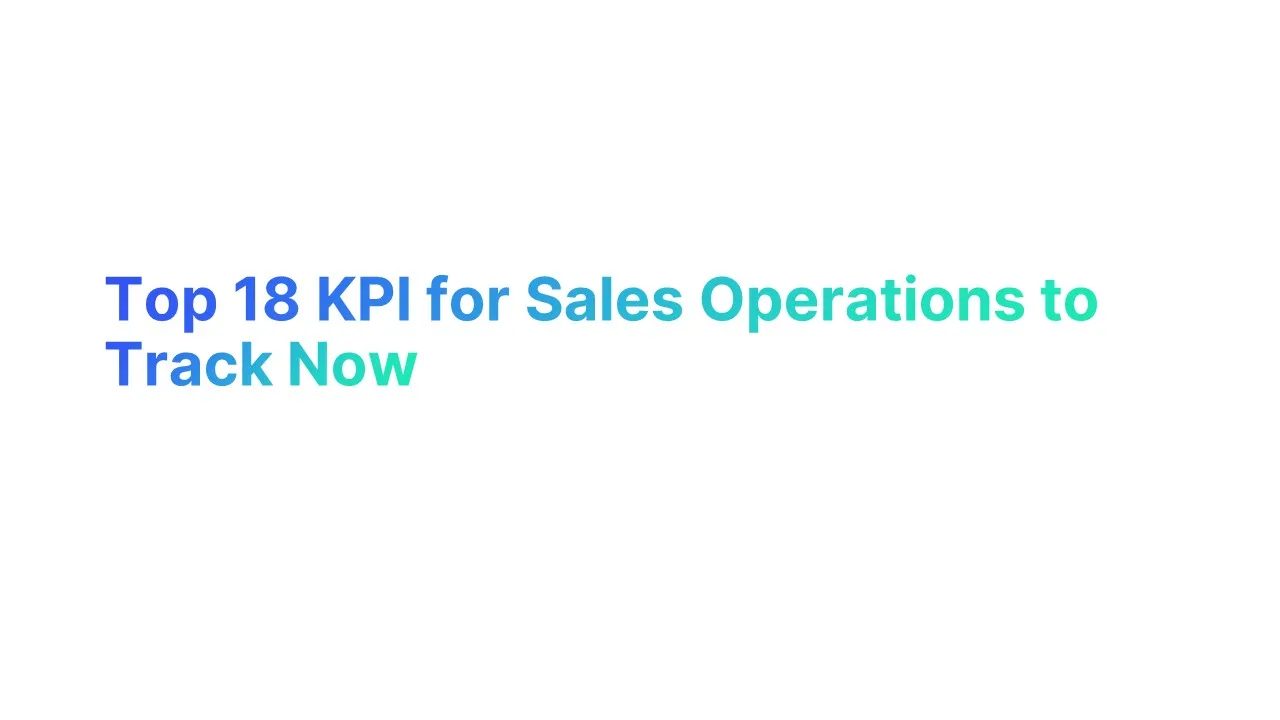Introduction to KPIs in Sales Operations

Sales Operations KPIs refer to the key performance indicators that help organizations measure the effectiveness and efficiency of their sales operations. These metrics provide insights that guide strategic decision-making, optimize sales processes, and enhance sales team performance.
Here are some short statistics to highlight their importance:
- 25% Increase: Companies that effectively use sales KPIs see up to a 25% improvement in operational performance.
- 30% Higher Revenue: Organizations that align sales metrics directly with their business goals tend to have 30% higher sales growth.
- 50% Faster Reaction: Teams that monitor real-time KPIs can react to market changes 50% faster than those that don't.
Sales Operations KPIs measure various aspects of the sales process from lead generation to closing deals, encompassing metrics like sales cycle length, conversion rates, and customer acquisition costs.
By keeping a pulse on these KPIs, businesses can streamline their sales operations, foster better sales strategies, and ultimately drive more revenue.
Importance of Tracking Sales Operations KPIs
Tracking Sales Operations KPIs is essential for any business aiming to enhance its sales performance and streamline its sales process. These metrics provide invaluable insights into the effectiveness of your sales strategies and the efficiency of your sales team.
1. Optimize Sales Process
- Monitoring KPIs like the sales cycle length and lead response time can significantly reduce inefficiencies, leading to a more streamlined sales process.
- Companies that actively manage sales cycle length have reported up to a 30% reduction in the time it takes to close deals.
2. Improve Sales Team Performance
- KPIs such as win rate and quota attainment rate are directly linked to individual and team performance.
- Teams that track their win rates can improve their closing ratios by up to 25%, as they are better able to identify and replicate successful sales behaviors.
3. Financial Health
- Financial KPIs like average deal value and customer acquisition cost give a clear picture of the economic impact of the sales operations.
- A focus on customer acquisition cost helps companies optimize marketing spend, which can decrease these costs by up to 15%, increasing overall profitability.
4. Strategic Decision-Making
- By tracking sales operations metrics and sales ops kpis, organizations gain critical data that supports strategic decision-making and long-term planning.
- Analysis of sales operations metrics can reveal trends that affect resource allocation, such as increasing personnel during high-demand periods to boost sales efficiency.
Sales Operations KPIs

KPIs (Key Performance Indicators) for sales operations can be grouped based on different aspects of sales management and execution. Grouping these KPIs helps in focusing on various strategic areas of sales operations. Here are some of the critical KPIs bracketed into relevant groups:
Efficiency KPIs
These KPIs help measure the efficiency of the sales process, focusing on the optimization of resources and time.
1. Sales Cycle Length
Sales Cycle Length is the average time it takes from initial contact with a prospect to closing the deal. It’s a primary indicator of sales efficiency.
Impact on Efficiency:
- A shorter sales cycle length indicates a more efficient sales process, allowing teams to close more deals in less time.
- Studies show that a 10% reduction in the sales cycle length can lead to a 15-20% increase in sales productivity.
2. Lead Response Time
This metric measures the time taken by sales teams to respond to a lead after it is generated.
Relevance:
- A prompt response to leads can dramatically increase the chances of conversion, as responsiveness is often equated with customer service and reliability.
- Companies that respond to leads within an hour are nearly 7 times more likely to have meaningful conversations with decision-makers than those who respond after even 60 minutes.
3. Average Onboarding Time
This KPI tracks the average duration it takes to fully integrate a new client into the company’s system after they have signed on.
Strategic Importance:
- Efficient onboarding processes ensure that new clients have a positive initial experience, setting the stage for a strong ongoing relationship.
- Reducing onboarding time by 25% has been linked with a 5% increase in client retention rates.
Performance KPIs
These KPIs assess the effectiveness and outcomes of the sales teams' efforts.
4. Win Rate
Win Rate is the percentage of sales opportunities that convert into actual sales. It's a direct measure of sales success and team efficacy.
Significance:
- A high win rate suggests effective sales tactics and strong customer alignment.
- Increasing the win rate by just 5% can boost revenue by 20% in many industries, demonstrating the high leverage of this metric.
5. Quota Attainment Rate
This KPI measures the percentage of sales representatives who meet or exceed their sales targets within a given time frame.
Business Impact:
- It reflects the overall health of the sales department and its alignment with business objectives.
- Organizations where over 60% of sales reps meet their quotas tend to exceed their revenue goals by 25%.
6. Conversion Rate
The conversion rate is the ratio of leads that turn into paying customers. It’s critical for understanding the efficiency of the sales funnel.
Strategic Insights:
- This KPI helps identify the effectiveness of the sales and marketing strategies.
- A 10% improvement in conversion rates can lead to a 50% increase in sales, depending on the industry and pricing strategies.
Financial KPIs
Focused on the financial aspects of sales operations, these KPIs are critical for assessing profitability and revenue generation.
7. Revenue Per Sales Rep
This KPI measures the total revenue generated by each sales representative over a given period.
Financial Insight:
- It helps assess the productivity and effectiveness of individual salespeople.
- An increase in revenue per sales rep by 5% can reflect improvements in sales tactics or market conditions, leading to enhanced profitability.
8. Gross Margin
Gross Margin represents the difference between revenue and the cost of goods sold (COGS), expressed as a percentage of revenue.
Business Impact:
- A vital indicator of the company’s pricing strategy and production efficiency.
- Industries with higher gross margins are typically more capable of absorbing cost fluctuations without affecting profitability.
9. Average Deal Size
This KPI calculates the average revenue generated from each closed deal.
Strategic Importance:
- Larger deal sizes can indicate more successful upselling strategies or a move towards a more premium market segment.
- Increasing the average deal size by 10% can lead to a significant revenue boost, assuming stable sales volume.
Customer Relationship KPIs
These KPIs track how effectively the sales team manages and develops customer relationships.
10. Customer Lifetime Value (CLV)
CLV measures the total revenue a business can reasonably expect from a single customer account throughout the business relationship.
Business Impact:
- Higher CLV indicates strong customer relationships and effective upselling or cross-selling strategies.
- Improving CLV by 10% can lead to an increase in overall profitability by up to 30%, depending on customer acquisition costs and retention strategies.
11. Customer Retention Rate
This metric shows the percentage of customers who remain engaged with the company over a specified period.
Significance:
- High retention rates are often correlated with customer satisfaction and product/service quality.
- A 5% increase in customer retention typically increases profits by 25% to 95%, as retained customers tend to buy more and are cheaper to serve.
12. Net Promoter Score (NPS)
NPS assesses customer satisfaction and loyalty by measuring the likelihood of customers recommending the company to others.
Strategic Insights:
- A high NPS is a strong predictor of growth and indicates successful customer relationship management.
- Companies with leading NPS scores in their industries outgrow their competitors by more than double in most cases.
Activity KPIs
These KPIs focus on the daily activities and operations within the sales team.
13. Calls Made
This KPI tracks the number of sales calls made by each sales rep within a specific timeframe.
Operational Insight:
- Monitoring calls made helps assess sales rep activity levels and their direct engagement with prospects.
- An increase in call volume by 20% often correlates with a rise in lead generation by approximately 15%, assuming consistent call quality.
14. Emails Sent
Measures the total number of sales-related emails sent by the sales team to prospects and customers.
Relevance:
- This metric is crucial for evaluating the scale and effectiveness of email marketing campaigns within sales operations.
- Effective email campaigns see open rates around 20-30% in B2B sectors, making this a critical metric for gauging engagement.
15. Meetings Scheduled
Tracks the number of meetings sales reps set up with potential or existing clients.
Strategic Importance:
- Scheduled meetings are strong indicators of interest and potential sales progression.
- A high number of scheduled meetings can indicate effective preliminary sales activities, with studies showing that increasing meeting frequency by 10% can boost conversion rates by 5%.
Strategic KPIs
These KPIs provide insights into the strategic aspects of sales operations and their alignment with business goals.
16. Market Penetration
Market Penetration measures the extent to which a product or service is known and used in a target market segment compared to the total estimated market.
Strategic Insight:
- A high level of market penetration indicates successful marketing and sales efforts and a strong presence in the target market.
- Achieving a 10% increase in market penetration can lead to a proportional increase in market share, enhancing competitive advantage.
17. Customer Acquisition Cost (CAC)
CAC calculates the total cost spent on acquiring a new customer, including all marketing and sales expenses.
Business Impact:
- Lowering CAC while maintaining or increasing acquisition rates maximizes marketing efficiency and profitability.
- Companies that optimize their customer acquisition strategies can reduce CAC by up to 15%, significantly increasing ROI.
18. Sales Pipeline Health
Sales Pipeline Health assesses the quality and status of opportunities within the sales pipeline at various stages from lead generation to closing.
Operational Significance:
- A healthy pipeline is indicative of a consistent flow of quality leads and well-managed sales processes.
- Regular pipeline reviews revealing a 20% increase in qualified leads can lead to a 10% uplift in closed deals, depending on sales execution.
How to use KPIs to Optimize Sales Operations

To effectively optimize sales operations using KPIs, businesses must adopt a structured approach that aligns with their strategic goals. Here’s a straightforward method to leverage KPIs for enhancing the efficiency and performance of sales operations teams:
1. Identify Key Metrics
Begin by determining which KPIs are most relevant to your sales strategy. Common choices include average sales cycle length, win rate, and customer acquisition cost. Each KPI should directly correlate with specific aspects of your sales operations.
2. Set Clear Targets
For each KPI, establish clear, achievable targets based on historical data and future aspirations. These targets will serve as benchmarks for measuring performance and identifying areas for improvement within the sales operations team.
3. Integrate KPIs into Daily Operations
Ensure that KPI tracking is part of the daily routine for the sales operations teams. Sales teams should have easy access to real-time data and understand how their actions influence overall performance. Tools like CRM software can automate data collection and visualization, making it easier for the sales ops team to stay informed.
4. Regular Review and Analysis
- Weekly/Monthly Reviews: Conduct regular meetings with the sales operations team to review KPIs. Discuss what’s working and what’s not.
- Quarterly Audits: Every quarter, perform a comprehensive audit of all KPIs to evaluate the effectiveness of your sales strategy and make necessary adjustments.
5. Use Data-Driven Insights for Training and Development
- Pinpoint skills or knowledge gaps based on KPI outcomes. For instance, if the win rate is low, additional training in negotiation or product knowledge might be necessary for the sales ops team.
- Tailor training programs to address these specific areas, enhancing the overall skill set of the sales operations teams.
6. Foster a Culture of Continuous Improvement
- Encourage sales operations teams to focus on KPIs by linking them to incentives and rewards.
- Celebrate achievements when targets are met or exceeded to motivate continuous effort and focus.
7. Leverage Technology
Implement advanced analytics tools and CRM platforms that provide deeper insights into each KPI. These tools can help predict trends, automate reporting, and suggest actionable improvements based on data patterns for the sales ops team.
8. Adjust Strategies Based on Market Feedback
- Continuously refine your sales approach based on KPI trends and market changes.
- Be flexible and ready to pivot strategies if certain KPIs consistently underperform despite strategic efforts from the sales operations teams.
Concluding Thoughts
Mastering the top 18 KPIs for Sales Operations equips business leaders with the insights needed to refine strategies, boost efficiency, and enhance team performance. These key performance indicators are essential tools for understanding the sales process, from lead generation to closing deals, and they enable informed decision-making that can significantly impact a company's bottom line. By continuously monitoring these metrics, organizations can not only meet their current sales objectives but also adapt to market changes and customer needs, ensuring sustainable growth and competitiveness in their industry.








